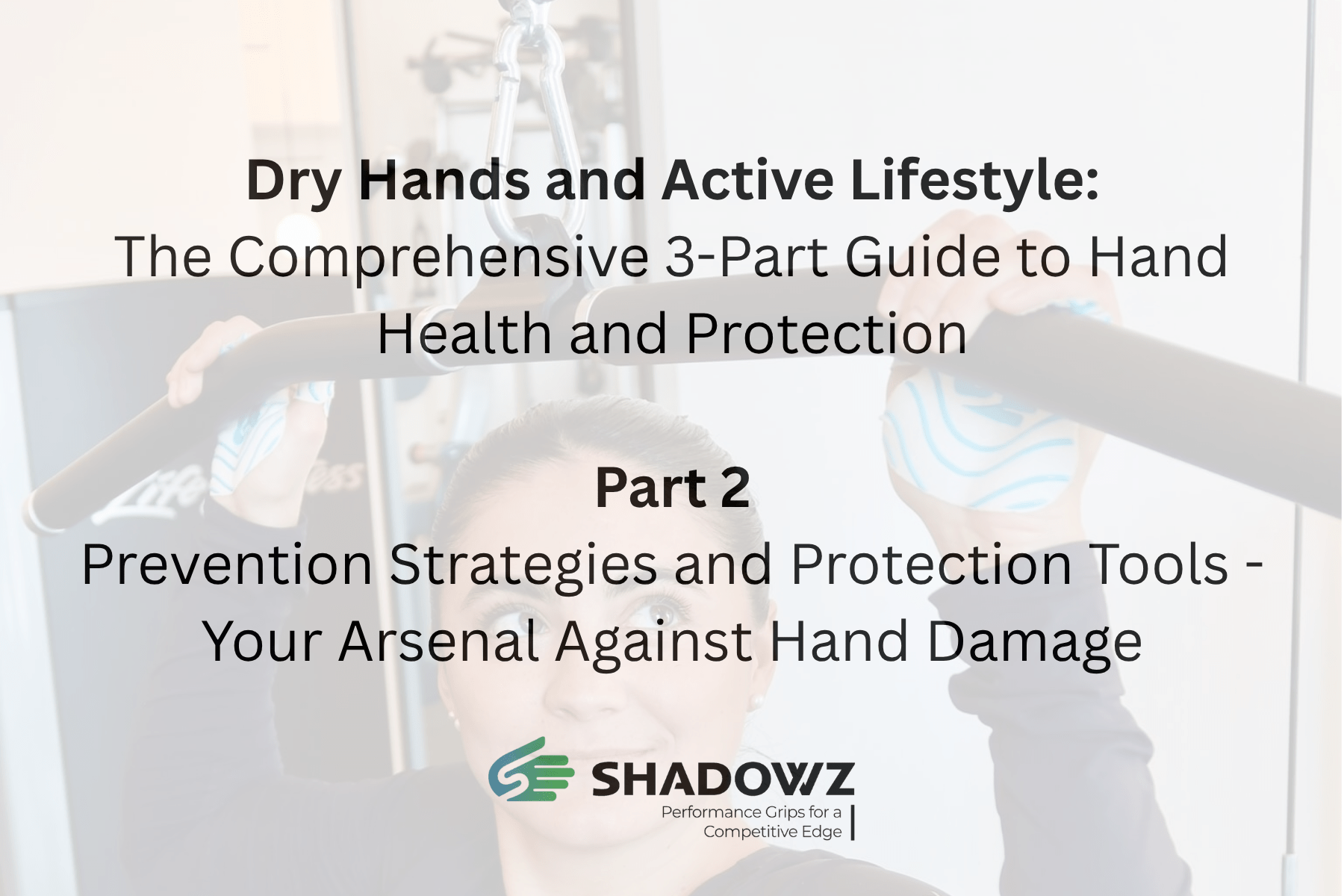This is Part 2 of a 3-part series on protecting your hands during active pursuits. Part 1 covered the science behind exercise-induced hand damage. Part 3 will focus on recovery protocols and long-term hand care.
Now that you understand how exercise damages your hands, it's time to build your defense system. The most effective approach combines smart preparation, appropriate protection during activity, and strategic tool selection based on your specific training style.
Prevention isn't about avoiding all hand stress—that would mean avoiding the activities you love. Instead, it's about managing stress levels to stay within your hands' capacity to adapt and recover.
Pre-Activity Preparation: Setting Yourself Up for Success
The work begins before you touch a single weight or grip a climbing hold. Proper preparation can reduce hand damage by up to 60% according to sports medicine research.
Strategic Moisturizing
Moisturize Strategically: Apply a barrier cream containing ceramides or lanolin 15-20 minutes before activity. This creates a protective layer without compromising grip. Avoid petroleum-based products immediately before exercise, as they can make equipment slippery.
The Science: Ceramides are naturally occurring lipids that help maintain the skin barrier. Pre-activity application helps prevent moisture loss during exercise while maintaining grip security.
Pro Tip: Apply the cream, then wash your hands lightly with just water (no soap) right before training. This removes surface residue while leaving the protective layer intact.
Proper Warm-Up Protocol
Proper Warm-Up: Include hand and wrist mobility in your warm-up routine. Gentle finger flexion and extension increases blood flow and prepares the skin for stress.
A comprehensive hand warm-up should include:
- 10 slow fist clenches and releases
- Individual finger extensions against light resistance
- Wrist circles in both directions
- Gentle palm stretches against a wall
Nail Management
Nail Management: Keep nails trimmed short and filed smooth. Long or rough nails can catch on equipment and create tears that extend into the palm.
File nails in one direction rather than back-and-forth to prevent splitting. Keep them just long enough to provide fingertip protection but short enough that they don't interfere with gripping.
During Activity: Protection Tools and Techniques
Your choice of protection should match both your activity and your personal priorities. Here's a comprehensive breakdown of options from basic to advanced.
Traditional Approaches and Their Applications
1. Chalk: The Classic Choice
Benefits: Superior grip enhancement, affordable, widely available, allows maximum tactile feedback
Drawbacks: Highly drying, messy, requires frequent reapplication, can damage equipment
Best Applications:
- Powerlifting and Olympic lifting
- Rock climbing and bouldering
- Gymnastics rings and bars
Usage Tips:
- Use sparingly—more isn't always better
- Combine with liquid chalk for longer-lasting coverage
- Always moisturize immediately after training
2. Standard Gym Gloves
Benefits: Basic palm protection, some grip enhancement, widely available
Drawbacks: Often trap moisture, reduce tactile feedback, can bunch up and cause blisters, may slip during heavy lifting
Best Applications:
- Light to moderate weightlifting
- General fitness training
- Beginners building tolerance
What to Look For:
- Breathable materials like mesh or perforated leather
- Proper fit—snug but not tight
- Reinforcement in high-wear areas
3. Gymnastics Grips
Benefits: Excellent for bars and rings, prevent major tears, designed for high-friction environments
Drawbacks: Sport-specific, limited versatility, can be bulky for other activities
Best Applications:
- High bar work and pull-ups
- Ring training and muscle-ups
- CrossFit workouts with extensive bar work
Advanced Protection Solutions
Liquid Chalk: The Hybrid Approach
Liquid chalk combines the grip benefits of traditional chalk with longer-lasting coverage. The alcohol base evaporates, leaving a thin chalk layer that adheres better to skin.
Advantages over Traditional Chalk:
- Longer-lasting application
- Less messy
- Better for humid environments
- Gym-friendly (less residue on equipment)
Ideal Use Cases:
- Long training sessions
- Humid environments
- Gyms with chalk restrictions
The Shadowz Grips Revolution
Traditional hand protection fails because it treats all grip activities the same way. Shadowz Grips represents a breakthrough in understanding how different activities stress hands differently.
The Innovation: Their patented FlexBarrier™ technology addresses the core problem—most protective gear either compromises grip quality or fails to prevent skin damage. Shadowz Grips uses a multi-layer system that:
- Maintains Natural Grip Feel: Ultra-thin construction preserves tactile feedback while providing protection
- Targets Stress Points: Reinforced areas correspond to common callus and tear locations
- Breathes with Activity: Moisture-wicking properties prevent the trapped sweat that leads to bacterial growth
- Adapts to Movement: Flexible materials move with your hands rather than restricting natural motion
Clinical Results: Testing showed users experienced:
- 89% reduction in new callus formation
- 94% fewer training-limiting hand injuries
- 76% improvement in post-workout hand comfort scores
When Shadowz Grips Excel:
- CrossFit workouts with mixed implements
- Extended weightlifting sessions
- Functional fitness training
- Any activity requiring grip precision and endurance
Activity-Specific Protection Strategies
Weightlifting and Powerlifting
Primary Concerns: Bar placement pressure, chalk drying effects, callus management
Recommended Approach:
- Pre-treat hands with barrier cream
- Use Shadowz Grips for high-volume training days
- Apply chalk only to fingertips for heavy singles
- Vary grip positions when possible
Advanced Tip: For deadlifts, consider alternating between mixed grip and straps to distribute stress patterns.
CrossFit and Functional Fitness
Primary Concerns: Rapid equipment transitions, mixed movement patterns, high training frequency
Recommended Approach:
- Prepare for mixed implements (bars, kettlebells, ropes)
- Emphasize quick protection that doesn't interfere with transitions
- Shadowz Grips excel in this varied environment
- Keep emergency tape for unexpected tears
- Focus on efficient grip techniques to reduce unnecessary stress
Rock Climbing and Bouldering
Primary Concerns: Fingertip stress, extended sessions, outdoor conditions
Recommended Approach:
- Balance grip enhancement with skin preservation
- Use chalk strategically—brush excess off regularly
- File down calluses weekly to prevent tears
- Consider finger taping for problem routes
- Moisturize heavily between climbing days
Climate Considerations: Adjust protection based on humidity and temperature. Hot, dry conditions require more aggressive moisturizing protocols.
Gymnastics and Calisthenics
Primary Concerns: High-friction bar work, dynamic movements, precision requirements
Recommended Approach:
- Protect against high-friction bar work with specialized grips
- Maintain hand flexibility for complex movements
- Address hot spots immediately with tape
- Consider sport-specific grips for advanced skills
- Practice grip transitions to minimize adjustment stress
Choosing Your Protection System
Your optimal protection system depends on several factors:
Training Intensity and Frequency
- High Volume/Frequency: Invest in advanced solutions like Shadowz Grips
- Moderate Training: Combination of chalk and basic gloves may suffice
- Occasional Training: Simple moisturizing and basic protection
Personal Priorities
- Performance Priority: Focus on minimal interference options
- Appearance Priority: Emphasize prevention over treatment
- Comfort Priority: Choose maximum protection even if it affects performance slightly
Budget Considerations
- High Budget: Advanced protective gear, multiple specialized tools
- Moderate Budget: Quality basics plus one advanced solution
- Low Budget: Focus on technique and basic protection with excellent recovery protocols
Implementation Strategy
Week 1-2: Assessment and Baseline
- Document current hand condition with photos
- Note problem areas and pain points during regular training
- Establish baseline grip strength and endurance measurements
Week 3-4: Basic Implementation
- Introduce pre-activity moisturizing routine
- Add hand warm-up to existing routine
- Begin with one new protective tool appropriate to your primary activity
Week 5-8: System Refinement
- Adjust protection based on initial results
- Add activity-specific tools as needed
- Fine-tune application techniques
Week 9+: Advanced Optimization
- Consider upgrading to advanced solutions like Shadowz Grips based on results
- Develop sport-specific protection protocols
- Establish maintenance routines for equipment
Coming Up in Part 3
Prevention and protection are only two-thirds of the equation. In Part 3 of this series, we'll cover:
- Immediate post-workout care protocols
- Long-term recovery strategies
- Advanced treatment for damaged hands
- Building a comprehensive hand health system
- Troubleshooting common problems
- When to seek professional help
The goal isn't perfect hands—it's functional, healthy hands that support your active lifestyle without limiting your potential. With the right prevention and protection strategies in place, you're already well on your way to achieving that balance.
Continue with Part 3: Recovery Protocols and Long-Term Hand Care, where we'll complete your hand health system with effective recovery and maintenance strategies.





